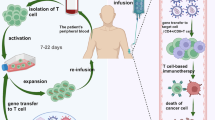Summary
CD46 is not only identified as a complement regulatory protein which protects host cells from complement attack, but also a new co-stimulatory molecule for human T cells. CD3/CD46 co-stimulation can induce a T-regulatory 1 cell (Tr1)-specific cytokine phenotype in human CD4+ T cells. However, the role of CD46 as a co-stimulatory molecule in the modulation of the acquired immunity, such as transplant immunology, remains unclear. In this study, CD4+ T cells were isolated from human CD46-transgenic C57BL/6 mice by magnetic-activated cell sorting, and further induced by anti-CD3, anti-CD28 and anti-CD46 antibodies respectively, and anti-CD3/anti-CD28 antibodies, anti-CD3/anti-CD46 antibodies, or the monoclonal antibody panel against CD3/CD28/CD46. The levels of interleukin-2 (IL-2), γ-interferon (γ-IFN), interleukin-10 (IL-10) and transforming growth factor-β (TGF-β) were detected in the supernatants of different groups. Suppression of allogeneic T cell proliferation were assessed by using mixed lymphocyte reaction (MLR) assay, in which monoclonal antibodies against CD46 were added to the culture. The results showed that CD3/CD28, CD3/CD46 and CD3/CD28/CD46 co-stimulation could significantly induce stronger proliferation of T cells than CD3 stimulation (P<0.05), and CD3/CD28/CD46 co-stimulation significantly increased the proliferation of T cells when compared with CD3/CD28 or CD3/CD46 co-stimulation (P<0.05 for each). IL-2 and γ-IFN levels were much higher in CD3/CD28 co-stimulation group than in CD3, CD28, CD46 and CD3/CD46 groups (P<0.05 for each). IL-10 and TGF-β levels were dramatically increased in CD3/CD46 co-stimulation group as compared with those in the CD3, CD28, CD46 and CD3/CD28 groups (P<0.05 for each). CD3/CD46 co-stimulation significantly inhibited the T cell proliferation and allogenic immune responses through the secretion of IL-10 and TGF-β in MLR (P<0.05). These results suggested that CD3/CD46 can induce Tr1 cells to modulate allogenic immune responses, and it may become a novel target for the development of new therapeutic approach for T-cell-mediated diseases. CD46 plays an important role in regulating the T cell-mediated immune responses by bridging innate and acquired immunity.
Similar content being viewed by others
References
Battaglia M, Gregori S, Bacchetta R, et al. Tr1 cells: from discovery to their clinical application. Semin Immuno, 2006,18(2):120–127
Cottrez F, Groux H. Specialization in tolerance: innate CD(4+)CD(25+) versus acquired TR1 and TH3 regulatory T cells. Transplantation, 2004,77(1 Suppl): S12–15
Barilla-LaBarca ML, Liszewski MK, Lambris JD, et al. Role of membrane cofactor protein (CD46) in regulation of C4b and C3b deposited on cells. J Immuno, 2002,168(12):6298–6304
Manchester M, Naniche D, Stehle T. CD46 as a measles receptor: form follows function. Virology, 2000,274(1): 5–10
Gill DB, Atkinson JP. CD46 in Neisseria pathogenesis. Trends Mol Med, 2004, 10(9):459–465
Assem MM, Gad WH, El-Sharkawy NM, et al. Prevalence of anti human herpes virus-6 IgG and its receptor in acute leukemia (membrane cofactor protein: MCP, CD46). J Egypt Natl Canc Inst,2005,17(1):29–34
Giannakis E, Jokiranta TS, Ormsby RJ, et al. Identification of the streptococcal M protein binding site on membrane cofactor protein (CD46). J Immunol, 2002, 168(9):4585–4592
Astier A, Trescol-Biemont MC, Azocar O, et al. Cutting edge: CD46, a new costimulatory molecule for T cells, that induces p120CBL and LAT phosphorylation. J Immunol, 2000,164(12):6091–6095
Kemper C, Chan AC, Green JM, et al. Activation of human CD4+ cells with CD3 and CD46 induces a T-regulatory cell 1 phenotype. Nature, 2003,421(6921): 388–392
Astier AL. T-cell regulation by CD46 and its relevance in multiple sclerosis. Immunology, 2008,124(2):149–154
Riley-Vargas RC, Gill DB, Kemper C, et al. CD46: expanding beyond complement regulation. Trends Immunol, 2004,25(9):496–503
Kemper C, Leung M, Stephensen CB, et al. Membrane cofactor protein (MCP; CD46) expression in transgenic mice. Clin Exp Immunol, 2001,124(2):180–189
Johansson L, Rytkonen A, Wan H, et al. Human-like immune responses in CD46 transgenic mice. J Immunol, 2005,175(1):433–440
Marie JC, Astier AL, Rivailler P, et al. Linking innate and acquired immunity: divergent role of CD46 cytoplasmic domains in T cell induced inflammation. Nat Immunol, 2002,3(7):659–666
Sanchez A, Feito MJ, Rojo JM. CD46-mediated costimulation induces a Th1-biased response and enhances early TCR/CD3 signaling in human CD4+ T lymphocytes. Eur J Immunol, 2004,34(9):2439–2448
Groux H. Type 1 T-regulatory cells: their role in the control of immune responses. Transplantation, 2003,75(9 Suppl):8S–12S
Levings MK, Roncarolo MG. T-regulatory 1 cells: a novel subset of CD4 T cells with immunoregulatory properties. J Allergy Clin Immunol, 2000,106(1 Pt 2):S109–112
Waldmann H, Graca L, Cobbold S, et al. Regulatory T cells and organ transplantation. Semin Immunol, 2004, 16(2):119–126
Roncarolo MG, Gregori S, Battaglia M, et al. Interleukin-10-secreting type 1 regulatory T cells in rodents and humans. Immunol Rev, 2006,212:28–50
Battaglia M, Stabilini A, Draghici E, et al. Rapamycin and interleukin-10 treatment induces T regulatory type 1 cells that mediate antigen-specific transplantation tolerance. Diabetes, 2006,55(1):40–49
Bacchetta R, Gregori S, Roncarolo MG. CD4+ regulatory T cells: mechanisms of induction and effector function. Autoimmun Rev Nov, 2005,4(8):491–496
Author information
Authors and Affiliations
Corresponding author
Additional information
This project was supported by a grant from National Natural Sciences Foundation of China (No. 30600573).
Rights and permissions
About this article
Cite this article
Chen, D., Zhang, Y., Li, M. et al. Suppression of allogeneic T cells proliferation by CD3/CD46-induced T-regulatory 1 cells. J. Huazhong Univ. Sci. Technol. [Med. Sci.] 30, 332–336 (2010). https://doi.org/10.1007/s11596-010-0352-5
Received:
Published:
Issue Date:
DOI: https://doi.org/10.1007/s11596-010-0352-5




